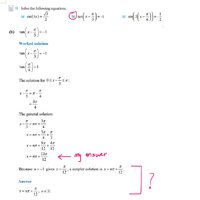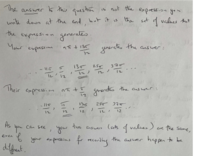You are using an out of date browser. It may not display this or other websites correctly.
You should upgrade or use an alternative browser.
You should upgrade or use an alternative browser.
Solving Trigonometric Equations
- Thread starter eutas1
- Start date
Steven G
Elite Member
- Joined
- Dec 30, 2014
- Messages
- 14,603
n*pi + 13pi/12 = n*pi + 1*pi + pi/12 (since13/12 = 1 + 1/12)
= (n+1)*pi + pi/12.
Since n can be any integer, then n+1 can be any integer. So you can just replace n+1 with m.
So the answer is m*pi + pi/12, where m is an integer.
But that is the same as just saying the answer is n*pi + pi/12.
The n in the last line and the n at the top line are just different n's!
= (n+1)*pi + pi/12.
Since n can be any integer, then n+1 can be any integer. So you can just replace n+1 with m.
So the answer is m*pi + pi/12, where m is an integer.
But that is the same as just saying the answer is n*pi + pi/12.
The n in the last line and the n at the top line are just different n's!
n*pi + 13pi/12 = n*pi + 1*pi + pi/12 (since13/12 = 1 + 1/12)
= (n+1)*pi + pi/12.
Since n can be any integer, then n+1 can be any integer. So you can just replace n+1 with m.
So the answer is m*pi + pi/12, where m is an integer.
But that is the same as just saying the answer is n*pi + pi/12.
The n in the last line and the n at the top line are just different n's!
I still don't understand...
Harry_the_cat
Elite Member
- Joined
- Mar 16, 2016
- Messages
- 3,779
Your answer is still correct. It is just that their final answer is simpler.
Your solution \(\displaystyle x=\frac{13\pi}{12} + n\pi\) generates the same set of solutions as the simpler solution given.
For your solution,
when \(\displaystyle n=-1\), \(\displaystyle x=\frac{\pi}{12}\),
when \(\displaystyle n=0\), \(\displaystyle x=\frac{13\pi}{12}\),
when \(\displaystyle n=1\), \(\displaystyle x=\frac{25\pi}{12}\), etc.
For the simpler solution,
when \(\displaystyle n=-1\), \(\displaystyle x=\frac{-11\pi}{12}\),
when \(\displaystyle n=0\), \(\displaystyle x=\frac{\pi}{12}\),
when \(\displaystyle n=1\), \(\displaystyle x=\frac{13\pi}{12}\), etc.
Your solution \(\displaystyle x=\frac{13\pi}{12} + n\pi\) generates the same set of solutions as the simpler solution given.
For your solution,
when \(\displaystyle n=-1\), \(\displaystyle x=\frac{\pi}{12}\),
when \(\displaystyle n=0\), \(\displaystyle x=\frac{13\pi}{12}\),
when \(\displaystyle n=1\), \(\displaystyle x=\frac{25\pi}{12}\), etc.
For the simpler solution,
when \(\displaystyle n=-1\), \(\displaystyle x=\frac{-11\pi}{12}\),
when \(\displaystyle n=0\), \(\displaystyle x=\frac{\pi}{12}\),
when \(\displaystyle n=1\), \(\displaystyle x=\frac{13\pi}{12}\), etc.
Ah, I get it now! Thank you so much!!
Your answer is still correct. It is just that their final answer is simpler.
Your solution \(\displaystyle x=\frac{13\pi}{12} + n\pi\) generates the same set of solutions as the simpler solution given.
For your solution,
when \(\displaystyle n=-1\), \(\displaystyle x=\frac{\pi}{12}\),
when \(\displaystyle n=0\), \(\displaystyle x=\frac{13\pi}{12}\),
when \(\displaystyle n=1\), \(\displaystyle x=\frac{25\pi}{12}\), etc.
For the simpler solution,
when \(\displaystyle n=-1\), \(\displaystyle x=\frac{-11\pi}{12}\),
when \(\displaystyle n=0\), \(\displaystyle x=\frac{\pi}{12}\),
when \(\displaystyle n=1\), \(\displaystyle x=\frac{13\pi}{12}\), etc.
I still didn't understand after I read your comment, but I get it now after reading the next one. I'm a bit slow... Thank you for your input!!
Ah, I get it now! Thank you so much!!
Good, as long as you've got it - that's the main thing!
Glad it helped.



